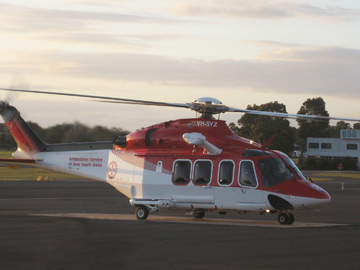
The ATSB is warning of the dangers of improvising or modifying established procedures after a winching accident resulted in the death of a paramedic.
On Christmas Eve 2011, an emergency personal locator beacon was activated in the Budderoo National Park, about 16 km south-west of Wollongong, NSW. A rescue helicopter at Bankstown Airport was assigned to track to the beacon and departed, carrying a pilot, an air crewman, two paramedics and a doctor.
The crew located the beacon at a waterfall known as Bridal Veil Falls. A canyoner’s abseiling rope had failed, and he had fallen onto a rock ledge near the bottom of the falls, suffering serious injuries.
The crew conducted an aerial reconnaissance of the area and assessed that, because of the terrain and vegetation, it would not be possible to winch personnel directly to the injured canyoner’s position and that vertical winch retrieval would similarly not be possible. Instead, the pilot landed at a nearby clear area and the crew devised a plan to access and retrieve the patient.
As the helicopter moved toward the position to commence the retrieval, the paramedic and the patient were accidentally pulled from the ledge and fell several metres, hitting rocks.
One of the paramedics abseiled down to the patient, taking the end of a second rope (the tag line) with him. The other paramedic remained at the top of the waterfall, holding the other end of the line. The helicopter hovered over the top of the waterfall and lowered the winch hook, and the tag line was used to facilitate delivery of the hook to the ledge. Because the helicopter could not hover directly over the patient’s location, it hovered off to the side, and the idea was for the paramedic and the patient to move out under it, and use a stabilising rope attached to the terrain to ensure they did not swing.
Due to fading light, and issues with the use of radios it was difficult for the parties in the helicopter and on the ground to communicate effectively. As the helicopter moved toward the position to commence the retrieval, the paramedic and the patient were accidentally pulled from the ledge and fell several metres, hitting rocks. The paramedic died from the impact. The patient was subsequently transported to hospital for treatment.
The ATSB investigation into the accident identified several safety issues relating to training and to the use of the helicopter’s lighting and radios.
As a result, the Ambulance Service of New South Wales and the helicopter operator have taken a number of measures to improve the safety of their operations. These safety actions have included revising their procedures, expanding their training programs, and impressing upon their staff the importance of adhering to appropriate procedures.
Rescue crews are frequently confronted with difficult situations and may be presented with rescue tasks they have not previously experienced. However, if they implement procedures that are not documented, or for which they have received no training, then it can be extremely difficult to identify hazards and manage the related risks.
Read the report: Helicopter winching accident involving an Agusta Westland AW139, VH-SYZ, 16km west-south-west of Wollongong Airport, New South Wales, on 24 December 2011


